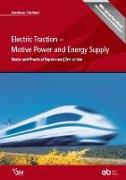- Start
- Electric Traction - Motive Power and Energy Supply
Electric Traction - Motive Power and Energy Supply
Angebote / Angebote:
This book has evolved from the lecture series "Elektrische Bahnen" ("Electric Railways") which has been held at Ruhr-Universität Bochum since 1996. Its primary audience are students of electrical energy technologies, control engineering and mechanical engineering as well as young engineers of electrical engineering, especially in the fields of power electronics, in railway industry and in railway-operating companies.
The book intends to convey mechanical fundamentals of electric railway propulsion, which includes rail-bound guidance, transmission of traction effort from wheel to rail under the influence of non-constant levels of adhesion and the transmission of motor torque to a spring-mounted and thus swaying drive wheelset.
The focal point of the book will be the disposition of electric traction units powered by three-phase induction motors. We shall discuss the stationary and dynamical behaviour of the squirrel-cage induction motors and the principle and construction features of pulse-controlled inverters, as well as scalar and field-oriented control systems and four-quadrant power converters, feeding the DC link of the inverters.
As is appropriate to the lesser importance these drive systems have nowadays, we will consider DC and AC commutator motors only in a cursory fashion, as well as their voltage control.
Since the specific railway energy supply network being either separate from or connected to the national power utility is a key factor in operating electrical railway systems, chapter 13 will offer a detailed look at the various systems of railway power supply, under special consideration of converter technology in this field as, for example, the line interference of inverter-fed traction units (see chapter 14). Chapter 15 features an abridged overview of the most important systems of field-oriented control of induction motors and of an innovative speed-sensorless control approach for induction motor drives, having come into the commercial phase. Chapter 16 suggests further reading, while chapter 17 will provide lecture-oriented exercises (including sample solutions).
The lion's share of examples has been derived from central European samples of Electric Traction. This is amongst others due to fact that most fundamental research and design of locomotives utilizing power electronics took place in these countries.
Libri-Titel folgt in ca. 2 Arbeitstagen

